Growing shares of Republicans rate immigration and terrorism as top priorities
Pew Research Center conducted this study to understand the American public’s views as the most important priorities for the president and Congress to prioritize in the coming year. For this analysis, we surveyed 5,140 adults from Jan. 16-21, 2024.
Everyone who took part in this survey is a member of the Center’s American Trends Panel (ATP), an online survey panel that is recruited through national, random sampling of residential addresses. This way nearly all U.S. adults have a chance of selection. The survey is weighted to be representative of the U.S. adult population by gender, race, ethnicity, partisan affiliation, education and other categories. Read more about the ATP’s methodology.
Here are the questions used for the report and its methodology.
As President Joe Biden prepares to deliver his third State of the Union address on March 7, Americans view strengthening the economy as the top policy priority for Biden and Congress to address this year.
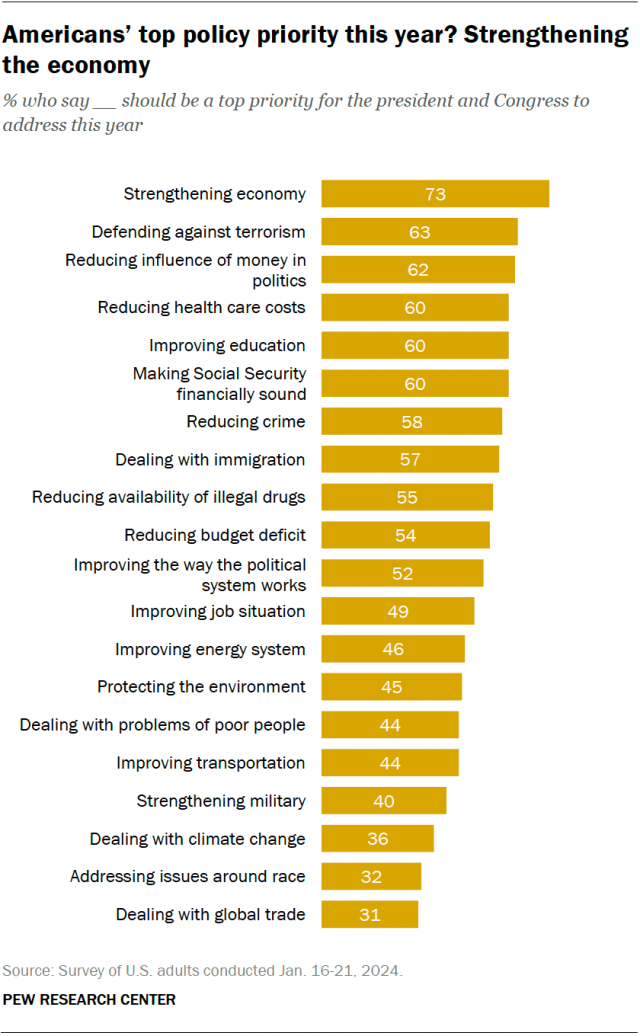
The public’s to-do list is little changed from the past two years, though it differs greatly from 2021, when dealing with the coronavirus ranked nearly as high as strengthening the economy on the policy agenda.
These are among the highlights of Pew Research Center’s annual policy priorities survey, conducted Jan. 16-21, 2024, among 5,140 adults:
No single issue stands out after the economy. Nearly three-quarters of Americans (73%) rate strengthening the economy as a top priority. That is considerably larger than the shares citing any other policy goal.
Republicans are increasingly concerned over immigration. Over the course of Biden’s presidency, the share of Americans citing immigration as a top priority has increased 18 percentage points – from 39% to 57% – with the change coming almost entirely among Republicans and Republican-leaning independents. Republicans have also grown more concerned over terrorism, especially in the past year.
Related: How Americans View the Situation at the U.S.-Mexico Border, Its Causes and Consequences
Crime is also a growing concern among Republicans. Nearly seven-in-ten Republicans and Republican leaners (68%) and 47% of Democrats and Democratic leaners say reducing crime should be a top policy priority. GOP concerns have risen steadily each year since 2021. Democratic views have been stable over the last few years after rising between 2021 and 2022.
There is bipartisan support for reducing the influence of money in politics. About six-in-ten Americans (62%) say reducing the influence of money in politics should be a top goal for the president and Congress. While there are wide partisan differences on most policy goals, 65% of Democrats and 60% of Republicans rate this as a top priority.
Related: Americans’ Dismal Views of the Nation’s Politics
Ongoing concerns: The economy, budget deficit and job situation
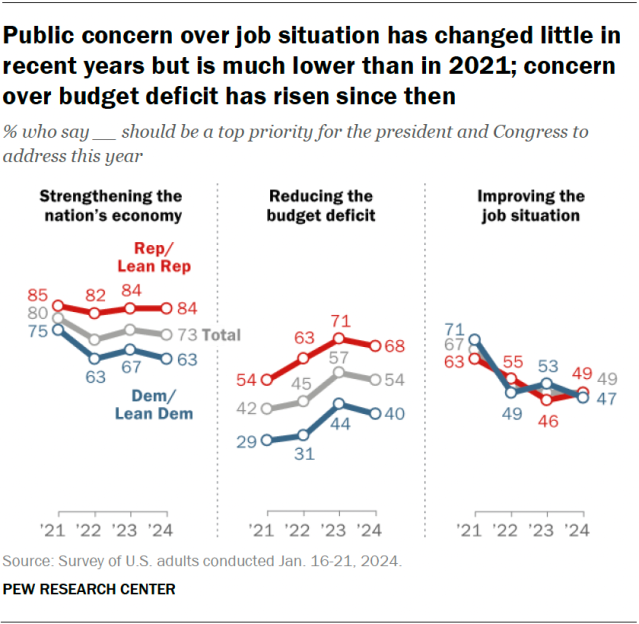
Large shares of Republicans and Republican-leaning independents (84%) and Democrats and Democratic leaners (63%) view strengthening the nation’s economy as a top priority this year, as they have for the past several years.
And while more Americans say the budget deficit is a top priority now than did when Biden first took office in 2021, their views are similar compared with last year (54% now vs. 57% then).
Republicans (68%) remain more concerned about the deficit than Democrats (40%).
By comparison, about half of the public (49%) – including nearly identical shares in both parties – view improving the job situation as a top priority. Concerns over the job situation have declined sharply since 2021, during Biden’s first year in office and when the coronavirus pandemic was ravaging the country.
Growing concerns: National security, crime and immigration
About six-in-ten Americans view defending the country from future terror attacks (63%), dealing with immigration (57%) and reducing crime (58%) as top political priorities for the upcoming year. And while Americans’ overall views of these policy areas are largely unchanged over the past year, Republicans are more concerned than Democrats about each.
Terrorism
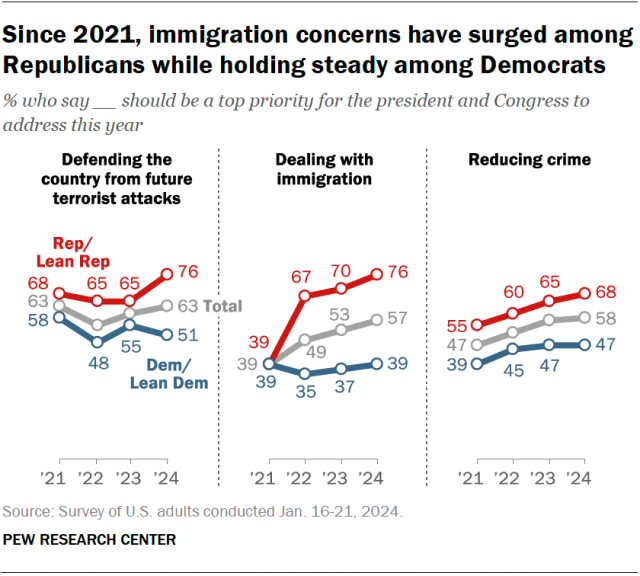
Among Republicans, concern about terrorism has risen 11 percentage points since last year (76% vs. 65%).
By comparison, about half of Democrats (51%) also view terrorism as a top priority this year (55% did so last year).
Immigration
Between 2021 and 2022, the share of Republicans citing immigration as a top policy priority rose sharply, from 39% to 67%.
Since then, it increased another 9 points, to 76%. Over this period, Democrats’ views have been fairly stable; today, 39% rate dealing with immigration as a top priority.
Reducing crime
While reducing crime has changed little as a priority since last year, both parties have become more concerned about it since the start of Biden’s presidency.
About seven-in-ten Republicans (68%) rate crime reduction as a top political priority, up 13 points since 2021. And roughly half of Democrats (47%) do the same (up 8 points over this period).
Wide partisan differences over most policy goals
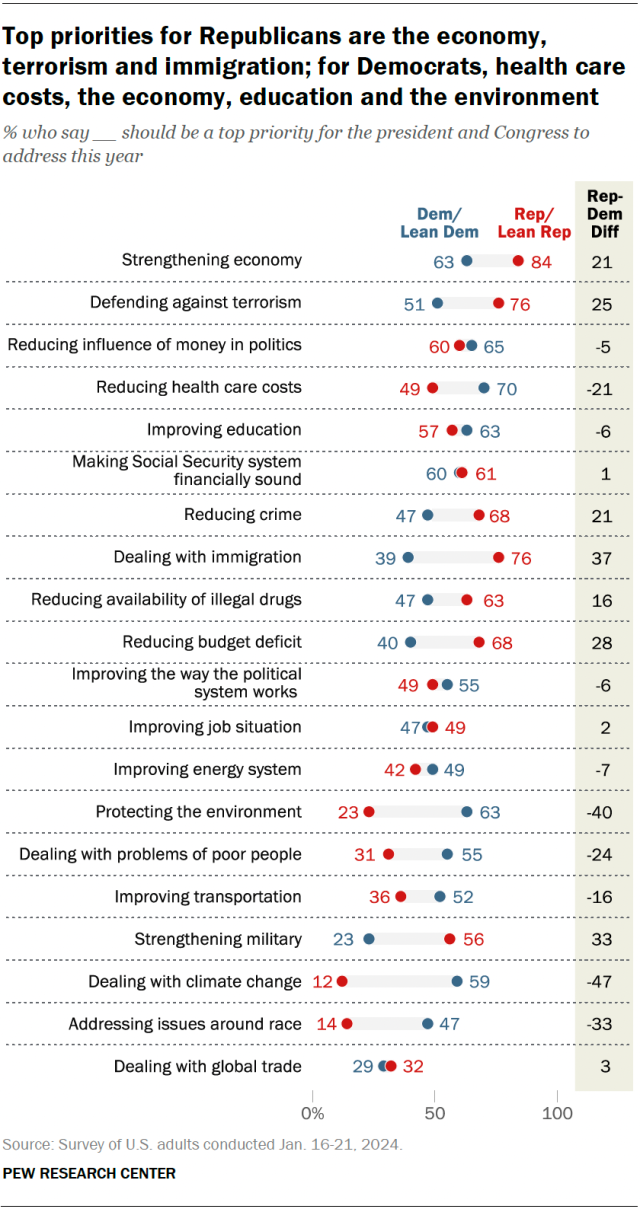
Although majorities in both major parties share several top priorities – such as strengthening the economy, reducing the role of money in politics and ensuring Social Security is financially sound – there are large differences on others.
For instance, Democrats are substantially more likely than Republicans to prioritize protecting the environment (63% vs. 23%) and dealing with climate change (59% vs. 12%).
By comparison, Republicans are much more likely to prioritize dealing with immigration (76% vs. 39%) and strengthening the military (56% vs. 23).
Differences by race and ethnicity
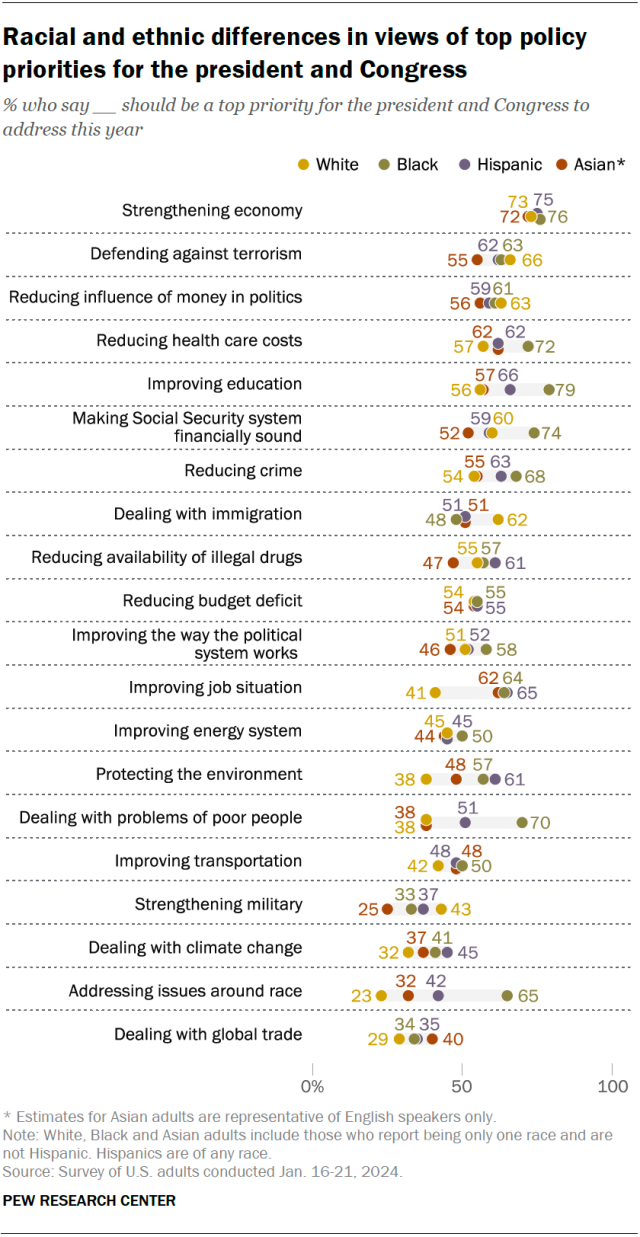
Clear majorities across racial and ethnic groups – about three-quarters each – view strengthening the economy as a top political priority this year.
They also uniformly prioritize defending the country against terrorism and reducing the influence of money in politics.
On other issues, differences are starker:
- While 41% of White adults prioritize improving the job situation, six-in-ten or more Black (64%), Hispanic (65%) and Asian Americans (62%) do the same.
- White and Asian adults (38% each) are far less likely than Hispanic (51%) and Black adults (70%) to prioritize dealing with problems of the poor.
- Black adults (65%) are substantially more likely to prioritize addressing issues around race than Hispanic (42%), Asian (32%) or White adults (23%).
Policy priorities by age
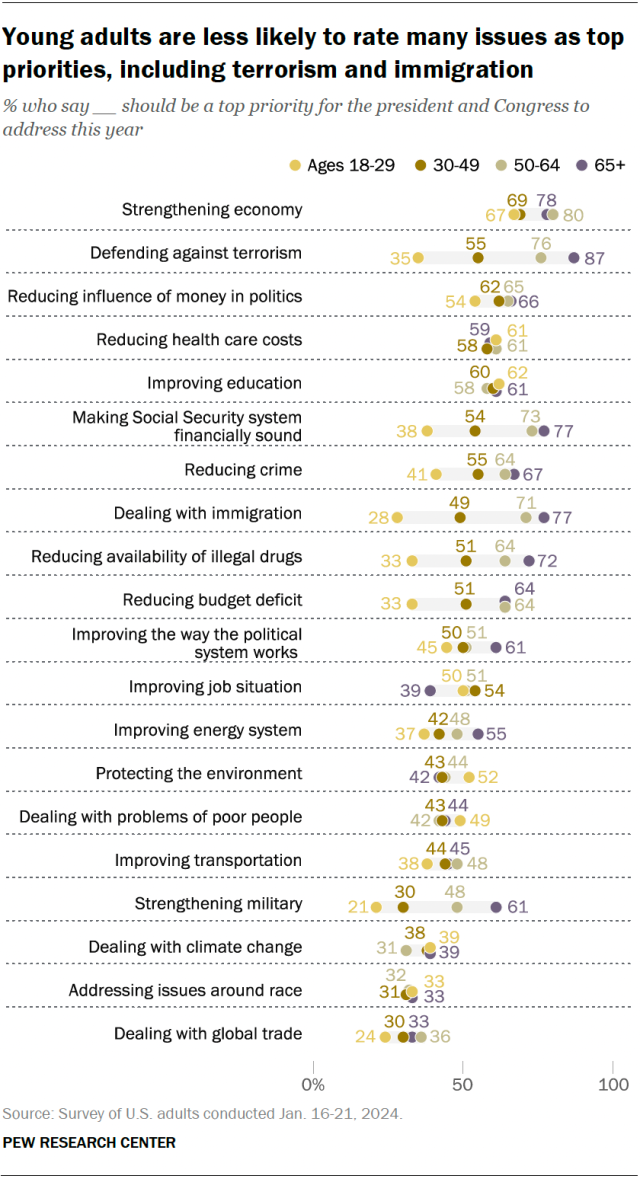
Similar shares of younger and older Americans view several issues as top priorities.
Across all age groups, about six-in-ten say reducing health care costs and improving education should be top political priorities this year.
But older Americans are particularly likely to prioritize some issues.
For example, nearly nine-in-ten people 65 and older (87%) and about three-quarters (76%) of those 50 to 64 say defending against terrorism should be a top priority. This drops to 55% of Americans 30 to 49 and 35% of those 18 to 29.
A similar pattern plays out for ensuring Social Security is financially sound, dealing with immigration, reducing the availability of illegal drugs and strengthening the military.
Few say policy objectives should not be pursued
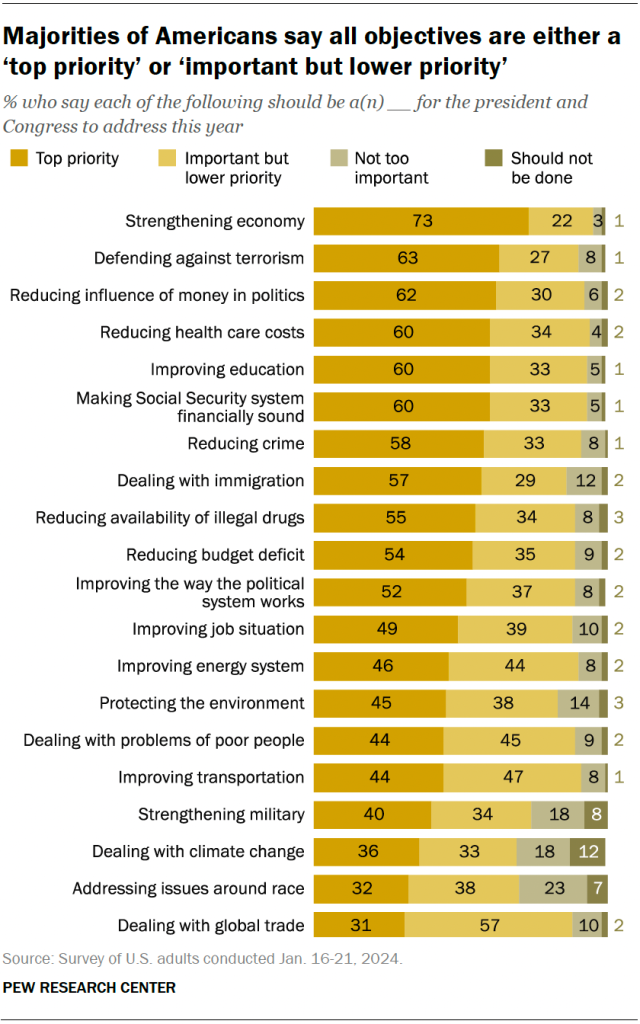
Despite wide differences over whether certain issues should be a top priority, relatively few say any of the issues asked about should not be prioritized by the president and Congress this year.
For all but three issues surveyed, few Americans (3% or less) say these policy areas should not be pursued. The exceptions are dealing with climate change (12%), strengthening the military (8%) and addressing issues around race (7%).
Similarly, relatively few say any of the policy areas are “not too important” to be addressed this year (at most, about a quarter say this for the same three policy issues).




